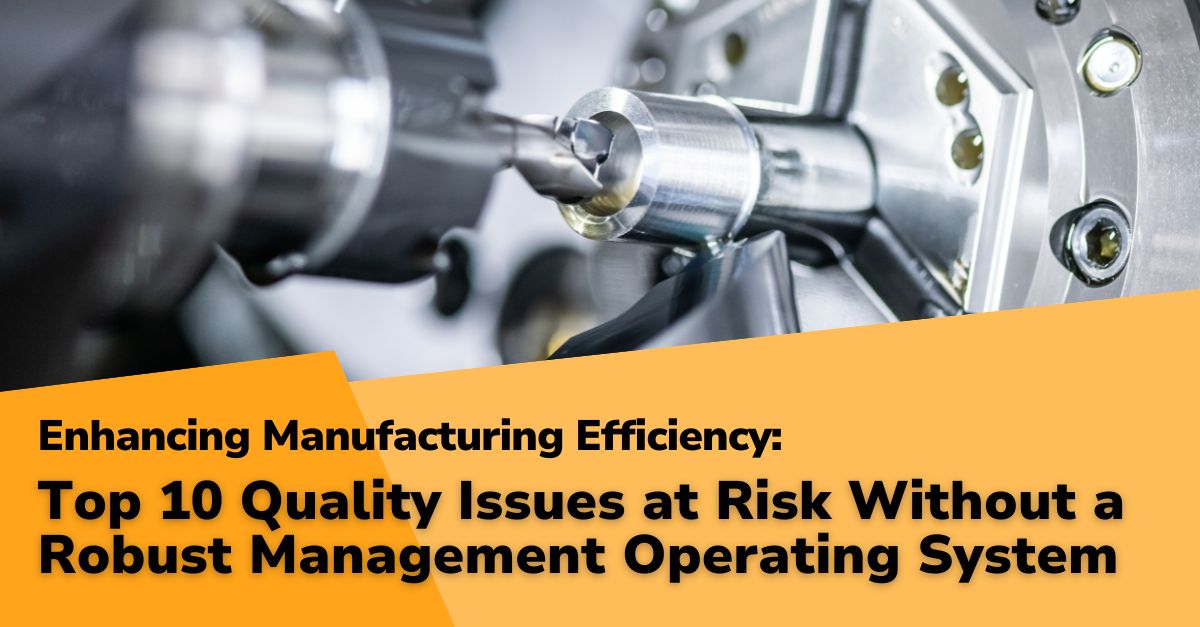
In manufacturing, quality isn’t just a KPI, it’s what determines customer retention, brand reputation, and long-term profitability.
Yet while many companies invest in better equipment or more inspections to boost quality, one of the most powerful drivers is often overlooked: the Management Operating System (MOS).
When this system is missing, or exists only on paper, quality problems take root. Operators wing it, standards drift, and defects become part of the routine.
This post explores 10 of the most common ways a weak or absent MOS damages product quality, and how these issues show up in real facilities.
1Increased Variability in Product Quality:
Without standardized processes, consistency becomes impossible. One shift does things by the book, another takes shortcuts to keep up with demand. Small differences, in material mix, machine setup, or inspection routines, create large variations in finished goods. And the more complex your product, the more costly those inconsistencies become. A strong MOS enforces standard work instructions, ensures clear expectations, and makes deviations visible fast.
2Ineffective Quality Control Systems:
An MOS doesn’t just schedule quality checks, it builds quality into every step of the workflow. Without that integration, inspections become afterthoughts or isolated from production. This creates blind spots where defects slip through. Teams may catch issues too late, wasting time and material. Worse, when frontline employees don’t own quality data, problems get seen as “someone else’s responsibility.” A well-structured MOS embeds accountability for quality at the point of execution, not just at final audit.
3Poor Traceability of Quality Issues:
When a defect is discovered, can you trace it back to the exact shift, line, operator, or batch? If not, you’re likely missing the systemic visibility that a mature MOS provides. Without integrated data capture, from raw materials to finished goods, root cause analysis becomes guesswork. And when you can’t isolate the problem, you can’t stop it from spreading. A strong MOS connects the dots across processes, helping teams solve issues faster and prevent repeat events.
4Delayed and Inadequate Response to Quality Problems:
Quality issues are inevitable, what matters is how fast you respond. A broken MOS often means there’s no clear chain of command when something goes wrong. Teams escalate too slowly (or not at all), while operators are left to improvise under pressure. In these environments, problems fester until they become emergencies. A well-structured MOS defines escalation paths, roles, and decision-making protocols, ensuring the right people are informed at the right time with the right information.
5Limited Opportunities for Continuous Improvement:
Sustained quality isn’t about catching defects, it’s about designing them out. But that requires a system that captures learnings, tracks patterns, and feeds them back into process improvement. Without an MOS to facilitate that loop, improvement efforts are sporadic at best. Operators may voice concerns, but nothing changes. Engineers might launch initiatives, but there’s no follow-up. A high-functioning MOS turns improvement from a one-off project into a daily discipline, measurable, repeatable, and led from the floor up.
6Inadequate Employee Training and Engagement:
A solid MOS links training directly to role expectations and quality outcomes. Without that system, new hires often shadow someone on the line, hoping to “pick it up” through observation. The result is uneven skill levels, inconsistent methods, and disengaged employees who don’t fully understand the why behind the work. When quality suffers, it’s rarely due to laziness, it’s a system failure in onboarding and communication. A robust MOS provides structured training pathways and reinforces them through daily execution.
7Inconsistency in Supplier Quality Management:
Your final product is only as good as the materials going into it. A missing or weak MOS often means supplier quality checks are inconsistent, poorly documented, or bypassed when production is behind schedule. This leaves your team scrambling to compensate for out-of-spec components or raw material variation. A comprehensive MOS sets clear supplier expectations, integrates incoming inspections into the workflow, and triggers corrective action when issues arise, before they reach the production line.
8Lack of Standardization Across Units:
In multi-site operations, lack of MOS alignment creates a patchwork of practices. One plant may enforce strict quality checks, while another skips them to meet demand. This inconsistency erodes brand trust and complicates scaling. Without a unified MOS, even the best-performing site struggles to share what works. Standardizing key quality systems across all sites, while allowing local flexibility, ensures customers get the same experience no matter where a product is made.
9Inefficient Resource Utilization:
When the MOS doesn’t guide how labor, equipment, and materials are deployed, waste creeps in. Overloaded teams cut corners. Underutilized assets sit idle while defects multiply elsewhere. Materials are rushed to the wrong station because priorities weren’t aligned during shift startup. A strong MOS doesn’t just manage production volume, it orchestrates the entire flow of resources to support quality at every stage.
10Eroded Customer Confidence and Loyalty:
The most damaging consequence of poor quality is also the most difficult to win back: trust. When customers start seeing quality issues, whether through defects, delays, or inconsistencies, their confidence takes a hit. That affects not just current contracts, but future bids and brand perception. An effective MOS helps teams fix quality problems at the source, prove stability through data, and give customers peace of mind that their expectations will be met, every time.
What It Means for Manufacturing Leaders
Quality issues are often symptoms, not root causes. If your team is dealing with repeat defects, untraceable problems, or missed improvement opportunities, the real issue may be the absence of a functioning Management Operating System.
Leaders can’t solve quality challenges with good intentions alone. You need a system that brings consistency to your processes, clarity to your data, and alignment across teams. That’s where a properly designed MOS becomes a game changer, not a bureaucracy, but a performance tool that sharpens execution at every level.
How POWERS Can Help
POWERS helps manufacturing organizations build and embed Management Operating Systems that actually work on the floor, not just in the conference room. We don’t drop in with binders and dashboards. We partner with your leadership and frontline teams to design systems that close the gap between intent and execution.
Here’s what sets our approach apart:
- Built-for-You MOS Design: We don’t copy and paste from other plants. We analyze your workflows, pain points, and people to create a custom system that fits your operation and drives measurable quality gains.
- Digital Production System (DPS): Our proprietary DPS platform equips leaders with real-time insights to track quality issues, prioritize response, and drive accountability across the operation.
- Training that Sticks: We embed training into the MOS itself, not as an add-on, so that employees learn, apply, and reinforce quality practices every day.
- Clear, Actionable Metrics: We help you monitor what matters, avoid information overload, and align KPIs with daily decisions that impact quality.
- Proven Results: From food processors to complex assembly operations, we’ve helped manufacturers reduce scrap, avoid recalls, and restore customer trust, all by fixing the system behind the quality.
Start Building a System That Delivers Real Quality
If you’re still relying on tribal knowledge or manual tracking to manage quality, it’s time for a change. A fully implemented Management Operating System turns quality from a goal into a habit, backed by structure, data, and aligned behaviors.
Let’s talk about how POWERS and our DPS platform can help your team build the system you need to consistently deliver products your customers count on.
Unlock the full potential of a robust Management Operating System with POWERS and set your path toward unparalleled operational excellence. Start your transformative journey today. For expert guidance and bespoke solutions, contact our team at +1 678-971-4711 or email info@thepowerscompany.com.
Continue Reading from this Mastery Series
- Part 1 - Identifying Key Inefficiencies in the Absence of a Management Operating System
- Part 2 - Top 10 Pitfalls: Lack of an MOS Derails Productivity
- Part 3 - Top 10 Quality Issues at Risk Without a Robust Management Operating System
- Part 4 - The High Cost of an Ineffective Management Operating System
- Part 5 - Without an Optimized Management Operating System, Decision-Making is Severely Impaired
- Part 6 - Scaling Challenges of an Inadequate Management Operating System
- Part 7 - The High Price of Low Engagement: Unpacking the Operational Impact of Employee Discontent
- Part 8 - Safeguarding Success: Decoding the Impact of Compliance and Safety Issues
- Part 9 - Examining the Cost of a Slow Response to Market Shifts
- Part 10 - Charting Success: Understanding the Costs of Losing Competitive Advantage








